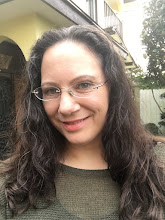
This is the old block. I can only guess the white line was to separate the traffic! These classrooms are closed now, I think they use this area just for storage.

The new corridor with basin area on the right for hand-washing. On the right you can see the bags hanging on hooks under the window.

A hook! For hanging bags! And a nice suburban Japanese house in the background. It's got more lawn than most houses have.

The class library sits outside the room, I think so the kids don't get distracted while they work. There's a big real library too in another wing, but each classroom has its set of age-appropriate books outside their room. 'Age-appropriate' means a lot more than subject-matter in Japan. In each year of school students learn Kanji (characters). So there are books that have only the characters First Years know, and others with all the characters that all primary school kids should know, but none of the ones you learn in Junior High School. Before they learn them, they learn a kind of alphabet called Hiragana, where each symbol stands for a sound, like the alphabet. (Look at the students' shoes box above, the ’の’ symbol is pronounced 'no'). They can use that to read anything, but books for adults and newspapers and magazines don't use these symbols, they use the characters, so everyone has to learn them.

Cleaning supplies. Another big difference between schools in Japan and New Zealand is that Japanese students have to clean the school. They get into a 'han' or mixed-grade group led by a 6th grade student, and they have to clean parts of the school, like sweeping and washing the corridors. With everyone doing it together, it doesn't take long. They even clean the toilets! That makes everyone be careful not to mess the place up too much. Everyone brings their own washcloth to school to use, but here is a pile of extras.
 This is the old block. I can only guess the white line was to separate the traffic! These classrooms are closed now, I think they use this area just for storage.
This is the old block. I can only guess the white line was to separate the traffic! These classrooms are closed now, I think they use this area just for storage.  The new corridor with basin area on the right for hand-washing. On the right you can see the bags hanging on hooks under the window.
The new corridor with basin area on the right for hand-washing. On the right you can see the bags hanging on hooks under the window. A hook! For hanging bags! And a nice suburban Japanese house in the background. It's got more lawn than most houses have.
A hook! For hanging bags! And a nice suburban Japanese house in the background. It's got more lawn than most houses have.  The class library sits outside the room, I think so the kids don't get distracted while they work. There's a big real library too in another wing, but each classroom has its set of age-appropriate books outside their room. 'Age-appropriate' means a lot more than subject-matter in Japan. In each year of school students learn Kanji (characters). So there are books that have only the characters First Years know, and others with all the characters that all primary school kids should know, but none of the ones you learn in Junior High School. Before they learn them, they learn a kind of alphabet called Hiragana, where each symbol stands for a sound, like the alphabet. (Look at the students' shoes box above, the ’の’ symbol is pronounced 'no'). They can use that to read anything, but books for adults and newspapers and magazines don't use these symbols, they use the characters, so everyone has to learn them.
The class library sits outside the room, I think so the kids don't get distracted while they work. There's a big real library too in another wing, but each classroom has its set of age-appropriate books outside their room. 'Age-appropriate' means a lot more than subject-matter in Japan. In each year of school students learn Kanji (characters). So there are books that have only the characters First Years know, and others with all the characters that all primary school kids should know, but none of the ones you learn in Junior High School. Before they learn them, they learn a kind of alphabet called Hiragana, where each symbol stands for a sound, like the alphabet. (Look at the students' shoes box above, the ’の’ symbol is pronounced 'no'). They can use that to read anything, but books for adults and newspapers and magazines don't use these symbols, they use the characters, so everyone has to learn them. Cleaning supplies. Another big difference between schools in Japan and New Zealand is that Japanese students have to clean the school. They get into a 'han' or mixed-grade group led by a 6th grade student, and they have to clean parts of the school, like sweeping and washing the corridors. With everyone doing it together, it doesn't take long. They even clean the toilets! That makes everyone be careful not to mess the place up too much. Everyone brings their own washcloth to school to use, but here is a pile of extras.
Cleaning supplies. Another big difference between schools in Japan and New Zealand is that Japanese students have to clean the school. They get into a 'han' or mixed-grade group led by a 6th grade student, and they have to clean parts of the school, like sweeping and washing the corridors. With everyone doing it together, it doesn't take long. They even clean the toilets! That makes everyone be careful not to mess the place up too much. Everyone brings their own washcloth to school to use, but here is a pile of extras.

No comments:
Post a Comment